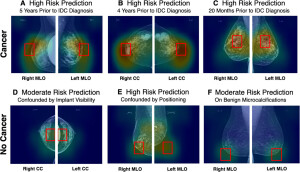por
John R. Fischer, Senior Reporter | March 25, 2024

A new AI model provides a simpler and more explainable prediction for a woman's risk of developing cancer over the next five years.
A new AI model lets women know their risk of developing cancer over the next five years based on their mammograms alone.
Researchers at Duke University in North Carolina have developed AsymMirai, a deep learning-based algorithm that is easier to understand than state-of-the-art solutions for breast cancer risk prediction. In a comparison study, the solution performed as well as one of these large and complex neural networks, Mirai, which provides little reason behind its decisions, creating the potential for overreliance by radiologists and incorrect diagnoses.
While mammography can lower a woman’s risk of dying from breast cancer and is the best way to determine treatment, precisely determining which women will develop breast cancer from screening alone is still not feasible.




Ad Statistics
Times Displayed: 18731
Times Visited: 356 Stay up to date with the latest training to fix, troubleshoot, and maintain your critical care devices. GE HealthCare offers multiple training formats to empower teams and expand knowledge, saving you time and money
In their investigation, the researchers found that differences between the left and right breast tissues were used to help detect but not predict cancer. Mirai was designed to make predictions based on such comparisons, allowing the researchers to create a modified, simpler version that was based on the front end of Mirai’s design, while replacing its complex methodology with local bilateral dissimilarity, an interpretable module that looks at tissue differences between the left and right breasts, thereby making it easier to understand its predictions.
“We can, with surprisingly high accuracy, predict whether a woman will develop cancer in the next one to five years based solely on localized differences between her left and right breast tissue. This could have public impact because it could, in the not-too-distant future, affect how often women receive mammograms,” said study lead author, Jon Donnelly, a student in the department of computer science at Duke, in a statement.
In the study, the researchers evaluated 210,067 mammograms captured between 2013 and 2020 from 81,824 patients in the EMory BrEast imaging Data set (EMBED) using Mirai and AsymMirai. For Mirai, the one-year risk prediction area under the receiver operating characteristic curve (AUC) was approximately 0.68, and the four-to-five year risk AUC was 0.69. For AsymMirai, the 1-year breast cancer risk AUC was 0.79 and the 5-year risk, 0.66. In a subgroup of 183 patients for whom AsymMirai repeatedly highlighted the same tissue over time, it achieved a 3-year AUC of 0.92.
In addition, the findings illustrated the clinical importance of breast asymmetry and how bilateral dissimilarity could be used as a future imaging marker for breast cancer risk. As a result, Donnelly and his colleagues see it potentially being used as an adjunct tool by human radiologists for breast cancer diagnoses and risk predictions.
The findings were published in
Radiology.

